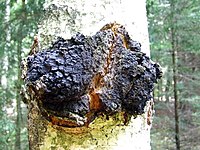Descripton
"Chaga, (Inonotus obliquus), also known as cinder conk, is a fungus in Hymenochaetaceae family. It is a parasitic fungus on Birch and other trees. The sterile conk is irregularly formed and has the appearance of burnt charcoal. The fertile fruitbody can be found very rarely as a resupinate (crustose) fungus on or near the clinker, usually appearing after the host tree is completely dead. I. obliquus grows in birch forests of Russia, Korea, Eastern Europe, Northern areas of the United States and in the North Carolina mountains. The Chaga mushroom is sold as a medicinal mushroom in the health supplement industry."[1]
"The Chaga conk grows with the birch tree for five to seven years during which time it absorbs nutrients and phytochemicals from the wood. When the chaga conk flower ripens it falls to the forest floor. Usually the host tree then dies, completing a 20 year cycle.
It is estimated that only about 0.025% of trees, only a few of every ten thousand, will grow a chaga conk. This makes the chaga mushroom somewhat rare even in its prime northern range."[6]
Chaga can also be drank as a tea, and supposedly has a rather pleasant flavor[4].
Research
"The Chaga mushroom (Inonotus obliquus) is claimed to have beneficial properties for human health, such as anti-bacterial, anti-allergic, anti-inflammatory and antioxidant activities. The antioxidant effects of the mushroom may be partly explained by protection of cell components against free radicals. We evaluated the effect of aqueous Chaga mushroom extracts for their potential for protecting against oxidative damage to DNA in human lymphocytes. Cells were pretreated with various concentrations (10, 50, 100 and 500 μg/mL) of the extract for 1 h at 37°C. Cells were then treated with 100 μM of H_2O_2 for 5~min as an oxidative stress. Evaluation of oxidative damage was performed using single-cell gel electrophoresis for DNA fragmentation (Comet assay). Using image analysis, the degree of DNA damage was evaluated as the DNA tail moment. Cells pretreated with Chaga extract showed over 40% reduction in DNA fragmentation compared with the positive control (100 μmol H_2O_2 treatment). Thus, Chaga mushroom treatment affords cellular protection against endogenous DNA damage produced by H_2O_2."[2]
"Inonotus obliquus BELYU1102 was selected from 12 different strains of Inonotus as a producer of immuno-stimulating polysaccharide. After a batch fermentation of I. obliquus BELYU1102 was carried out in a 300 l pilot vessel, endo-polysaccharide and exo-polysaccharide were both obtained. The proliferation activity of endo-polysaccharide for splenic cells was much higher than the activity of exo-polysaccharide. The active endo-polysaccharide was produced primarily during the late stationary phase. Enhanced proliferation and polyclonal IgM antibody production were observed in B cells by purified water-soluble endo-polysaccharide. Nitrite production and expression of IL-1beta, IL-6, TNF-alpha, and iNOS in macrophages were also enhanced. However, the endo-polysaccharide did not affect the proliferation of T cells, the IL-2 expression of Th1 cells, or the IL-4 expression of Th2 cells. The endo-polysaccharide showed activities similar to lipopolysaccharide (LPS) for B cells and macrophages, but there was a large difference between the two polysaccharides because cellular activations induced by endo-polysaccharide were not affected by polymyxin B, a specific inhibitor of LPS. The endo-polysaccharide appeared to have other cellular binding sites with TLR-4 and did not show a direct toxicity against tumor cells. However, indirect anti-cancer effects via immuno-stimulation were observed. The mycelial endo-polysaccharide of I. obliquus is a candidate for use as an immune response modifier. Submerged mycelial cultures are advantageous for industrial production of polysaccharides."[3]
"AIM: To investigate the anti-proliferative and apoptotic effects of Chaga mushroom (Inonotus obliquus) water extract on human hepatoma cell lines, HepG2 and Hep3B cells.References
METHODS: The cytotoxicity of Chaga extract was screened by 3-[4,5-dimethylthiazol-2-yl]-2, 5-diphenyltetrazolium bromide (MTT) assay. Morphological observation, flow cytometry analysis, Western blot were employed to elucidate the cytotoxic mechanism of Chaga extract.
RESULTS: HepG2 cells were more sensitive to Chaga extract than Hep3B cells, as demonstrated by markedly reduced cell viability. Chaga extract inhibited the cell growth in a dose-dependent manner, which was accompanied with G0/G1-phase arrest and apoptotic cell death. In addition, G0/G1 arrest in the cell cycle was closely associated with down-regulation of p53, pRb, p27, cyclins D1, D2, E, cyclin-dependent kinase (Cdk) 2, Cdk4, and Cdk6 expression.
CONCLUSION: Chaga mushroom may provide a new therapeutic option, as a potential anticancer agent, in the treatment of hepatoma."[5]
[1] Wikipedia Entry: Chaga Mushroom
[2] Chaga mushroom extract inhibits oxidative DNA damage in human lymphocytes as assessed by comet assay
[3] Immuno-stimulating effect of the endo-polysaccharide produced by submerged culture of Inonotus obliquus.
[4] Mushroom Collecting - Chaga
[5] Chaga mushroom (Inonotus obliquus) induces G0/G1 arrest and apoptosis in human hepatoma HepG2 cells
[6] The Chaga Natures Medicinal Mushroom



Killer entry
ReplyDelete